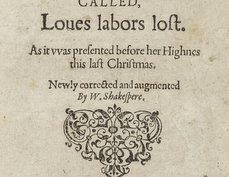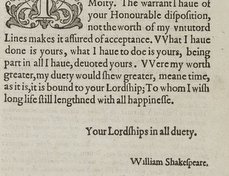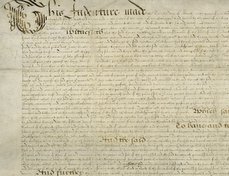William Shakespeare's purchase of New Place, one of the largest houses in Stratford-upon-Avon, is one of the best examples of his increasing affluence. He purchased it from William Underhill in the spring of 1597. The evidence that survives for Shakespeare's purchase consists of four documents relating to the final concord of 1597 and four documents relating to the final concord of 1602. For 1597, we have the concord itself, the note of fine, the foot of fine, and the exemplification of fine. For 1602, we have the engrossed triplicate (the buyer/plaintiff and vendor/defendant copies and the foot of fine) and the note of fine.
The legal process which resulted in a final concord, or fine, had its origin in a late twelfth-century method of settling land disputes, whereby the plaintiff (querens), brought an action in the Court of Common Pleas against the defendant (deforciens), which if upheld was engrossed (copied out in a court hand) in triplicate on a single sheet of parchment, and then cut into three with indented (wavy) edges. One copy, known as the “foot,” was left in the court records and the other two given to the plaintiff and defendant. In the event of a dispute, the copies could be brought together to establish authenticity.
However, fines were not precisely dated and were worded in a ritualized fashion, with the premises frequently described in summary form only. Therefore, parallel forms of conveyancing, providing more precise documentation, evolved, with fines over time simply serving to confirm that the conveyance had taken place. The procedure thus became a purely fictitious legal action, with the purchaser, described as the plaintiff, appearing in court to demand the property in question from the vendor, described as the defendant. On the vendor’s admission that the claim was valid, the property was then recognized as the buyer's. This engrossment of the transaction in a royal court thus served as a form of registered title, confirmed if necessary by the bringing together of the triplicate copies of the fine.
In Shakespeare's case, he appears in the documents as the buyer, or plaintiff, of a messuage, two barns and two gardens in Stratford. Underhill then recognized Shakespeare’s right to the premises. This was first acknowledged in a concord attested by Edward Anderson, one of the justices, and was then, in a note, written out according to a standard format. This was then copied out in triplicate, as described above. The court’s copy of the 1597 agreement, “the foot of fine,” remains to this day in the court’s archives but the copies given to Shakespeare and Underhill have not survived. Instead, Shakespeare went to the expense of securing an exemplification, or formal copy, of the agreement, which opens with a royal address (Elizabeth, by the grace of God, Queen of England, France, and Ireland, Defender of the Faith, etc.) and is sealed with the seal of the Court of Common Pleas. It is this copy which was later found amongst title deeds relating to his estate. Why Shakespeare went to these lengths is unclear, especially as exemplifications of this sort, if not rare, are uncommon. However, it has been argued that, due to Underhill’s unreliability in conveyancing matters and given that he died within a month or two of the New Place transaction, a formal conveyance may never have been drawn up, obliging Shakespeare instead to rely on this certified copy of the fine. This is given some substance by the survival of most of the other deeds for the New Place estate, both before and after Shakespeare’s purchase.
The sum of money recorded in a fine as changing hands was almost universally far less than the amount specified in a more detailed conveyancing deed (such as a bargain and sale) of the same property. The £60 here paid by Shakespeare is therefore highly unlikely to represent the actual sum he paid. In many cases, the true purchase price is frequently known to have been twice the sum named in the fine. If Shakespeare paid £120 for New Place, this would be in line with the sums paid when the house changed hands earlier in the sixteenth century.
Shortly after the sale in 1597, Underhill died, apparently poisoned by his eldest son, Fulke, who was prosecuted for the crime and hanged in 1599. Fulke's other estates reverted to the crown until his younger brother, Hercules, came of legal age in 1602. In that year, Hercules confirmed the sale of New Place to Shakespeare, probably arising out of Shakespeare's concern to protect his investment, resulting in a new final concord, of which the engrossed triplicate (including the foot of fine) still survives.
Co-written by Robert Bearman, Alan H. Nelson, and Folger Shakespeare Library staff.









